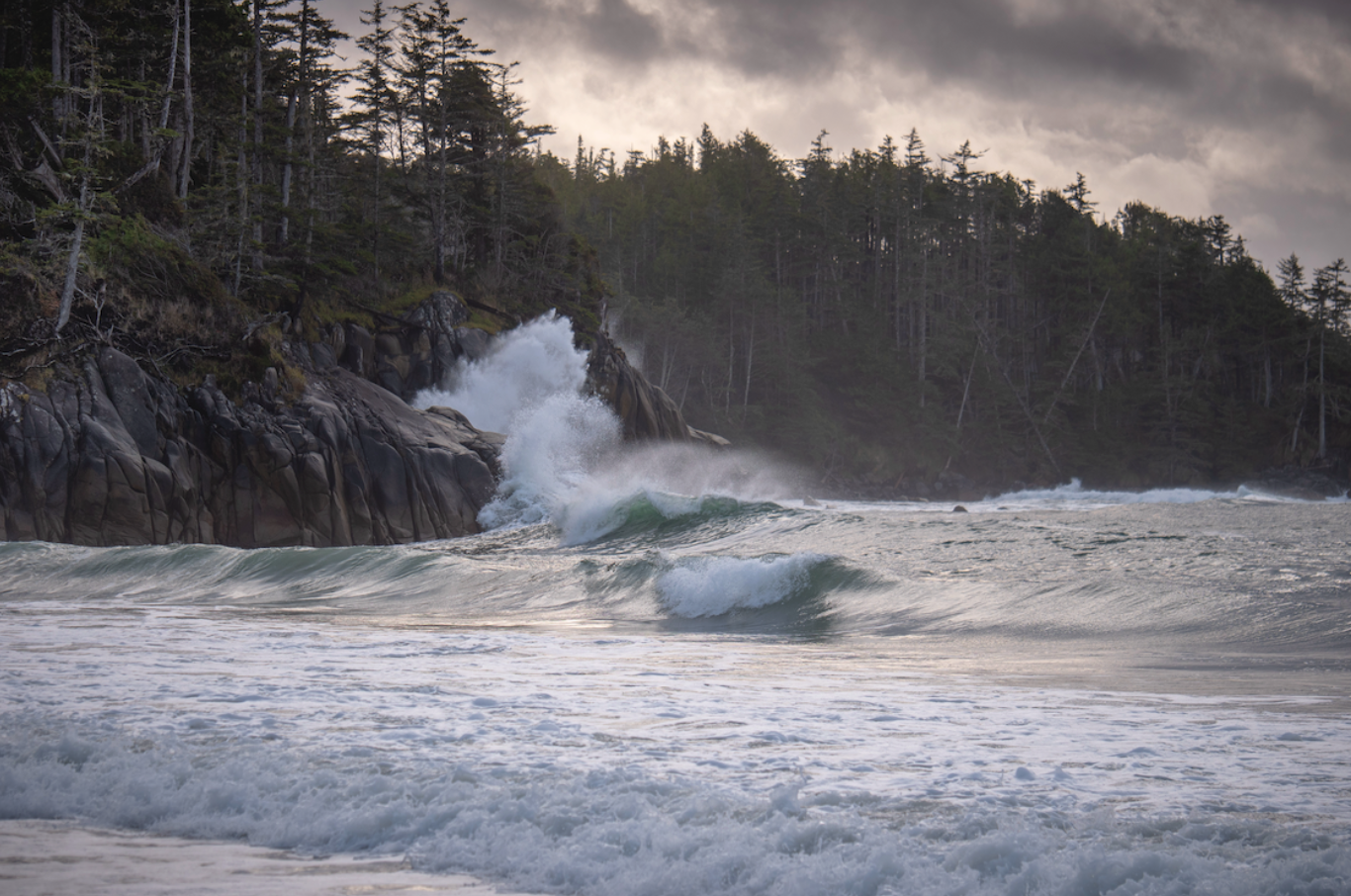A new research paper in Nature, led by Hakai Institute oceanographers and ecosystem scientists, shows that there is a link between storm season intensity in British Columbia and the patterns of ocean acidification in the northern Strait of Georgia.
Ocean acidification refers to decreasing pH levels in the marine environment, caused mainly by the ocean acting as a sink for the increasing atmospheric carbon dioxide (CO2) content—primarily from emissions released by human industrial activities such as burning fossil fuels. When CO2 is absorbed by seawater, it forms carbonic acid. This lowers the pH of seawater, making it more corrosive to calcium carbonate and leading to stressful conditions for marine animals that make shells.
Following weak storm seasons—where there were relatively few storms with high winds—researchers noted that extreme ocean acidification conditions manifested over the following year. The reverse happens following strong storm seasons when ocean acidification conditions are improved.
“The extreme ocean acidification conditions that follow weak storm seasons have the potential to impact every shell producer, from bivalves like clams and oysters to crustaceans,” says Wiley Evans, research scientist and lead oceanographer at the Hakai Institute.
Ocean acidification impedes their ability to produce a shell, explains Evans. “On top of that, not only do you get these extremely corrosive conditions, but you have very low pH levels that have been shown to impact larval decapods such as crab and shrimp.”
The effects of climate change on people and ecosystems are obvious in some cases: catastrophic floods and wildfires made more frequent and intense by a warming planet, are familiar to many. But not all the negative impacts of industrial atmospheric carbon dioxide pollution are immediately apparent. Ocean acidification is one such insidious phenomenon, with potentially far-reaching and disastrous effects on marine ecosystems and fisheries.
For many coastal communities from Mexico to Alaska, extreme ocean acidification conditions are not a future concern but a present reality that impacts lives and jobs. In 2020 in British Columbia, when indirect and induced effects are factored in, the seafood industry contributed over $1.5-billion to provincial GDP and employed over 14,000 people. British Columbia’s Ocean Acidification and Hypoxia Action Plan, released in 2023, notes that ocean acidification and the related phenomenon of hypoxia (low oxygen zones in the ocean) “poses a significant threat to BC's aquaculture and wild capture fisheries, as well as coastal ecosystems and communities.”
This new research paper by Evans and 18 other scientists from the Hakai Institute and other institutions shows the linkage between extreme ocean acidification conditions and storm season intensity, and, in doing so, provides some predictive capacity that may prove useful to coastal communities and the aquaculture industry. The results, says Evans, point to the need to better understand the biological impacts of such extreme ocean acidification conditions.
“There is a broad perception that, in terms of climate change-driven impacts on the environment, our house is on fire, so to speak, with high-profile disasters like wildfires frequently appearing in the news. But ocean acidification is not as much on our radar, because it is not ‘in our faces’ yet in the same way,” says Evans.
“Ocean acidification is perceived not as a ‘now’ problem but a ‘later’ problem, a slow burn that over time will become a real concern. What this research shows is that this is not the case—that conditions can change drastically from year to year in locations like the northern Strait of Georgia, becoming very extreme and with the potential for significant negative impacts on marine life. We need to maintain focus on this problem and work to better understand the implications for resident marine life.”
About the Study
The study results are based on eight years of biogeochemical data, drawn from a long-term monitoring station located in the northern Strait of Georgia.
Variability in storm season intensity modulates ocean acidification conditions in the northern Strait of Georgia, appeared in the Nature journal Scientific Reports in February 2025.
Evans, W., Campbell, K., Weekes, C. et al. Variability in storm season intensity modulates ocean acidification conditions in the northern Strait of Georgia. Sci Rep 15, 4505 (2025). https://doi.org/10.1038/s41598-025-88241-8
Contact
Wiley Evans, Hakai Institute research scientist
wiley.evans@hakai.org
250.797.4600
Additional Facts (see source release from the BC government)
Warmer water holds less oxygen, which leads to hypoxia, a state of low or depleted oxygen.
Concurrently, 26 percent of the atmospheric carbon dioxide is transferred to the ocean’s surface waters, which increases ocean acidity.
Ocean acidification is corrosive to shellfish, and, at current rate of emissions, the average surface ocean acidity is expected to increase by 100%–150% higher than preindustrial levels by the year 2100.
Download the media kit that includes this press release and photos for media.
About the Hakai Institute and Tula Foundation
Hakai Institute
The Hakai Institute, part of the Tula Foundation, is a British Columbia-based scientific institution dedicated to advancing science on the coastal margin. Hakai pursues its mission from ice fields to oceans, leveraging its ecological observatories and other strategic locations on the province’s coast. The Hakai Institute partners with universities, NGOs, First Nations, government agencies, businesses, and local communities to move the needle on advancing long-term coastal research. Learn more at www.hakai.org
Tula Foundation
The Tula Foundation is a British Columbia-based organization that harnesses science and technology to tackle urgent global issues. Tula takes a comprehensive approach to these challenges, from coastal biodiversity and public health to data management and mobilization. Along with rural healthcare in Guatemala, Tula's work drives pivotal action for coastal conservation and ocean research in British Columbia and beyond. Learn more at www.tula.org.


